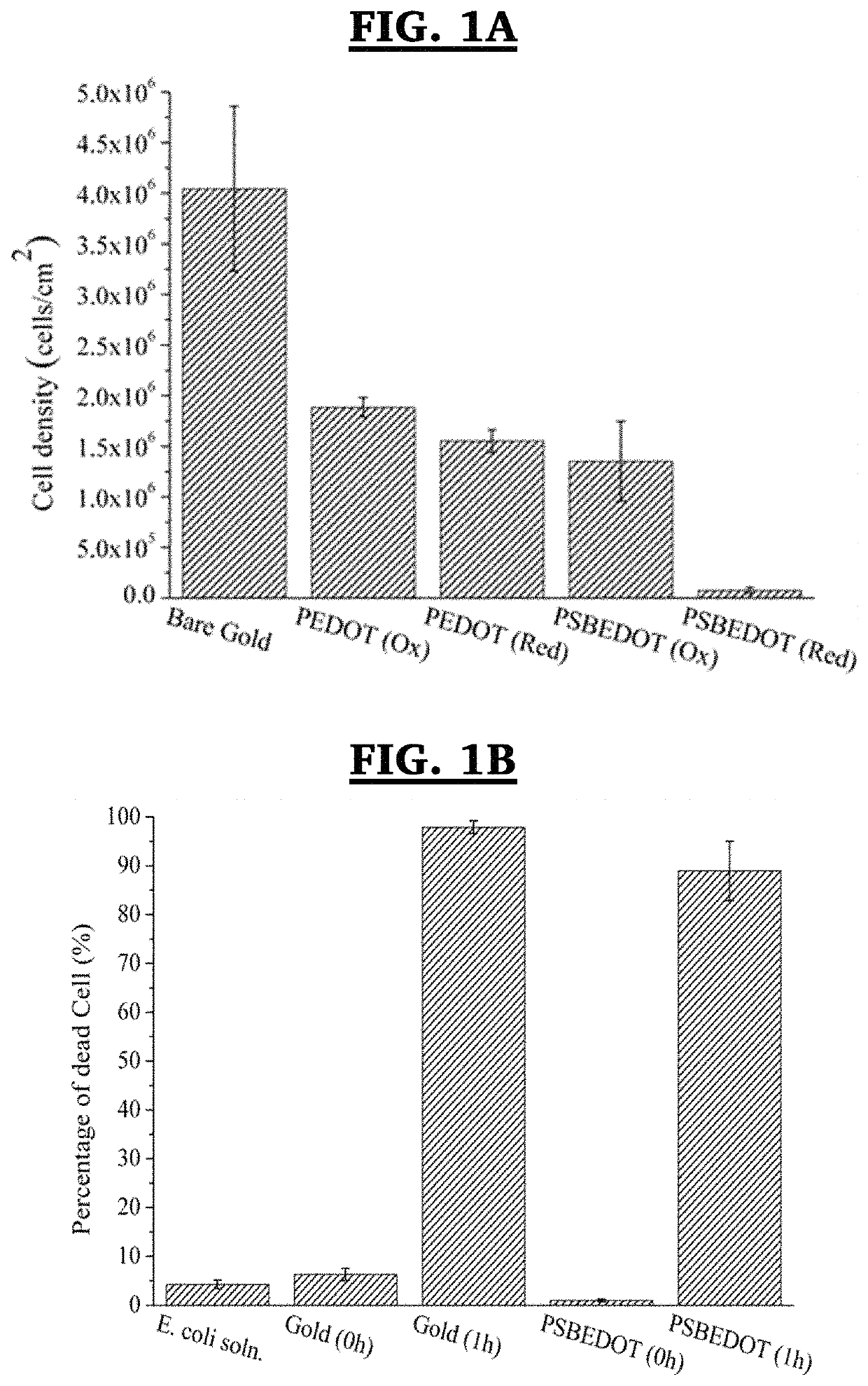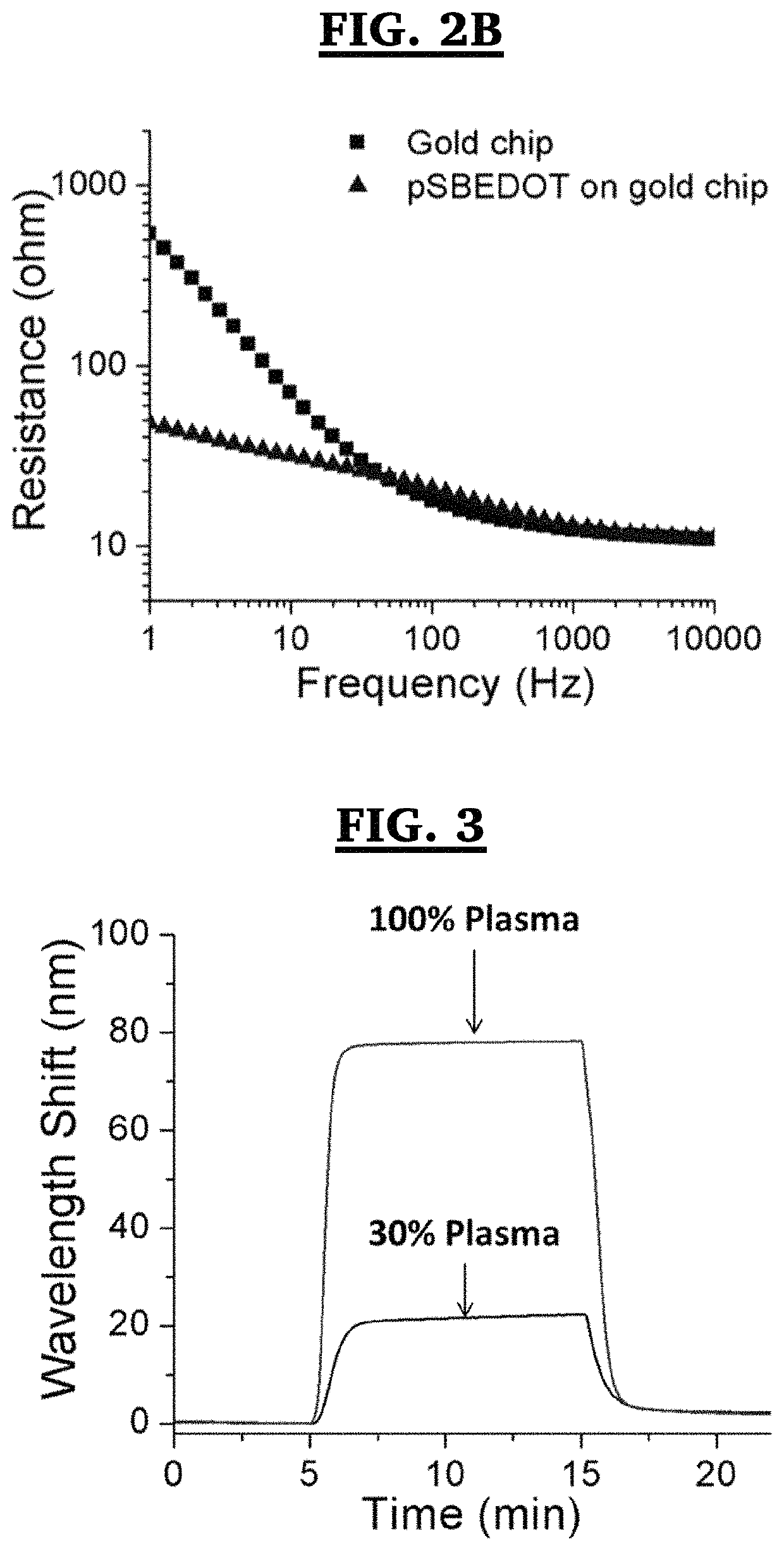Method for electropolymerization of hydrophilic EDOT monomers in an aqueous solution
a hydrophilic edot monomer and electropolymerization technology, which is applied in the direction of electrolytic organic material coating, electrolytically conductive paint, coating, etc., can solve the problems of reducing the sensitivity or causing the failure of embedded devices, non-conducting components of current conducting hydrogels are not effective enough to prevent long-term biofouling and foreign body response, and achieve excellent electrical conductivity , improve bioelectronic performance, the effect of increasing
- Summary
- Abstract
- Description
- Claims
- Application Information
AI Technical Summary
Benefits of technology
Problems solved by technology
Method used
Image
Examples
example 1
Synthesis of Chloromethyl-EDOT
[0070]Chloromethyl-EDOT was synthesized from 3,4-dimethoxythiophene following a method set forth in J. L. Segura, R. Gomez, R. Blanco, E. Reinold and P. Bauerle, Chem Mater, 2006, 18, 2834-2847, the disclosure of which is incorporated herein by reference in its entirety. EDOT-dimethylamine was synthesized as a versatile intermediate, which was used to synthesize zwitterionic EDOT derivatives bearing carboxybetaine or sulfobetaine side chains. Chloromethyl-EDOT is also commercially available from a variety of sources including Sigma Aldrich (St Louis, Mo.).
example 2
Synthesis of EDOT-dimethylamine (EDOT-DMA)
[0071]Chloromethyl-EDOT (3.8 g, 20 mmol) was added to a solution of dimethylamine (40 wt. % in H2O) (22.5 mL, 200 mmol) and acetonitrile (22.5 mL). The mixture was sealed in a schlenk flask and heated at 80° C. for 2 days. Another 22.5 mL of dimethylamine (40 wt. % in H2O) was added after it cooled down. Then the solution was heated at 80° C. for another 36 hours. After the solution cooled to room temperature, it was concentrated with a rotary evaporator, extracted with ether, dried with MgSO4. Product was purified with silica gel column chromatography (MeOH / CH2Cl2 / ethyl acetate, 1 / 10 / 10 (v / v / v)). Pure product was obtained as a light yellowish liquid (Yield: 65%). 1H NMR (300 MHz, CDCl3) δ 6.30-6.36 (m, 2H), 4.20-4.30 (m, 2H), 3.90-3.97 (m, 1H), 2.41-2.64 (m, 2H), 2.31 (s, 6H). 13C NMR (75 MHz, CDCl3) δ 141.84, 99.90, 99.55, 71.95, 67.52, 59.65 (one carbon not seen due to overlapping signal) (See FIGS. 6, 7)
example 3
Synthesis of SBEDOT
[0072]1,3-Propanesultone (1.46 g, 12 mmol) was slowly added into a solution of EDOT-dimethylamine (2.0 g, 10 mmol) in 50 mL of anhydrous THF. The mixture was heated at 55° C. for 36 hours under a positive nitrogen flow. After filtration, it was washed with THF and vacuum dried. The pure product was obtained as a white powder (Yield: 82%). 1H NMR (300 MHz, D2O) δ 6.58-6.65 (m, 2H), 5.00 (m, 1H), 4.14-4.31 (m, 2H), 3.62-3.85 (m, 4H), 3.27 (s, 3H), 3.25 (s, 3H), 2.98 (t, 2H, J=7.2 Hz), 2.22 (m, 2H). 13C NMR (75 MHz, D2O) δ 139.94, 138.45, 101.66, 101.00, 67.80, 65.90, 63.69, 62.55, 51.97, 51.69, 47.16 See FIGS. 8, 9.
PUM
| Property | Measurement | Unit |
|---|---|---|
| voltage | aaaaa | aaaaa |
| current density | aaaaa | aaaaa |
| current density | aaaaa | aaaaa |
Abstract
Description
Claims
Application Information
 Login to View More
Login to View More - R&D
- Intellectual Property
- Life Sciences
- Materials
- Tech Scout
- Unparalleled Data Quality
- Higher Quality Content
- 60% Fewer Hallucinations
Browse by: Latest US Patents, China's latest patents, Technical Efficacy Thesaurus, Application Domain, Technology Topic, Popular Technical Reports.
© 2025 PatSnap. All rights reserved.Legal|Privacy policy|Modern Slavery Act Transparency Statement|Sitemap|About US| Contact US: help@patsnap.com



